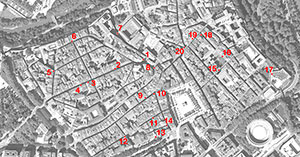Hornacinas of the historic center of Pamplona
By José Luque Valdivia
Burgo de San Cernin
|
|
|
|
|
|
|
2. SAN FERMÍN |
|
|
|
|
|
|
|
|
5. SAN LORENZO |
|
|
|
|
|
7. SAN FERMÍN |
|
|
|
Population of San Nicolás
|
|
|
|
|
|
|
10. CRUCIFIED CHRIST |
|
|
11. SAN NICOLÁS |
|
|
12. SAN GREGORIO |
|
|
13. SAN JOSE |
|
|
14. NICHE IN LINDACHIQUÍA STREET, ON THE CORNER OF COMEDIAS STREET |
Navarrería
|
|
|
|
|
|
|
16. COMPANY NO. 23 |
|
|
|
|
|
|
|
|
|
|
|
|
Introduction
A walk through the Historical Center allows us to discover in its facades an abundant issue of niches that testify to the social life that the different neighborhoods developed in the city of Pamplona. In them, the corresponding Boards were in charge of neighborhood services. Each one had its own patron saint and, in order to honor it, in a suitable place in the neighborhood they placed a niche with its image. In this way, not only did they show their devotion to patron saint, but also the role played by the Neighborhood Councils and, in a way, the skill that was established between them.
Later, when the function of these Juntas de Barrio was assumed by the City Hall, the conservation of those niches fell to the owners of the houses in which they were located. This meant in some cases the loss of the images, as evidenced by the empty niches that can be seen today in the Casco. sample . Others were privatized, but in addition new niches continued to appear, some promoted by the neighbors of the streets and others by individuals who adorned the facades of their houses.
As diverse as the images they host are the niches that show them. Only some of them are located in an open niche in the façade, leaving the hole open to the outside, or protected with glass. Others adopt singular solutions that have no repetition in the Casco, but those that use one of these solutions are more frequent: images of bulk or high reliefs that protrude from the plane of the facade by means of a bracket; or they are housed in a small cabinet attached to the facade, with a glazed door that allows the image to be seen.
The pathway that is proposed to recognize this aspect of the historical and ethnographic heritage of Pamplona goes through each of the three Burgos that were unified in 1423 by the Privilege of the Union, but that even today are still recognized in their peculiar layout, preserving their own character.
ARAZURI, J., Pamplona, streets and neighborhoods, Pamplona, Arazuri Díez, 1979.
BALEZTENA, J., "Calles del viejo Pamplona", Navarra, temas de cultura popular, 97, Pamplona, Government of Navarra, 1979.
GARCÍA GAINZA, M.ª C. (ed.) et al., Catalog Monumental de Navarra, V***. Pamplona: Príncipe de Viana / Archbishopric of Pamplona / University of Navarra, 1997.
HERRADÓN, M.ª A., "Reinaré en España. La devoción del Sagrado Corazón", Revista de Dialectología y Tradiciones Populares, LXIV, 2, 2009, pp. 193-218.
IRIBERRI, J. M., "Hornacinas del Casco Viejo", Diario de Navarra: I (May 30), II (June 6), III (June 13) and IV (June 20), 1983.
MARTINENA, J. J., "review de la evolución urbana de Pamplona", Príncipe de Viana, 207, 1996, pp. 143-176.
MARTINENA, J. J., "Escudos de armas en las calles de Pamplona", in M.ª del Mar Lazarra, Las calles de Pamplona: un lugar para la report, Pamplona, Pamplona City Council, 2007.
MORALES SOLCHAGA, E. "Un ejemplo de promoción confraternal: la casa de la Hermandad de San José y Santo Tomás de los carpinteros y albañiles de Pamplona", Cuadernos de la Chair de Patrimonio y Arte Navarro, 2, 2007, pp. 321-347.





















